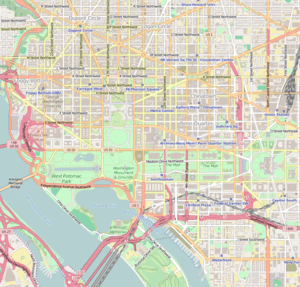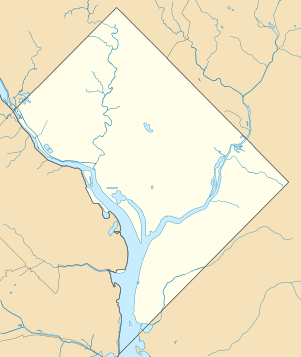District of Columbia City Hall
|
District of Columbia City Hall | |
|
| |
   | |
| Location |
451 Indiana Avenue NW Washington, D.C. |
|---|---|
| Coordinates | 38°53′43″N 77°1′4″W / 38.89528°N 77.01778°WCoordinates: 38°53′43″N 77°1′4″W / 38.89528°N 77.01778°W |
| Built | 1820 |
| Architectural style | Neoclassical |
| NRHP reference # | 66000857 |
| Significant dates | |
| Added to NRHP | 15 October 1966[1] |
| Designated NHL | 19 December 1960[2] |
District of Columbia City Hall, also known as "Old City Hall" and the "District of Columbia Courthouse", is an historic building at Judiciary Square in downtown Washington, D.C. facing Indiana Avenue. Originally built for the offices of the D.C. municipal government, the District's City Hall was subsequently used as a Federal courthouse, and was the scene of several notable criminal trials including those of three accused presidential assassins. The building was declared a National Historic Landmark in 1960.[2][3] It now houses the District of Columbia Court of Appeals.
History
The government of the City of Washington held a competition for the design of a new municipal building in 1818. George Hadfield, who had supervised construction of the United States Capitol from October 1795 to May 1798,[4][5] submitted a design for a new city hall, but it was judged to be too costly. Hadfield eventually won the competition in 1820 with a revised version of his original plan, and construction began in August. The offices of the city government moved into the building in 1822. However, a lack of funds and other problems hindered construction and the building would not be completed in its entirety until 1849.[3][6]
According to the NRHP nomination for the adjacent, compatibly-designed United States Court of Military Appeals Building (1910), the city hall building's south side plan is attributed to George Hadfield, but the north side plan is attributed to Robert Mills.[7]
To raise funds needed to finish the building, the city leased out space during construction to other federal government offices. Tenants included the U.S. Circuit Court and the Recorder of Deeds office, then headed by noted black leader and abolitionist Frederick Douglass, (1818–1895), who also later served as U.S. Marshal for the District. Following passage of the District of Columbia Compensated Emancipation Act in 1862, the Old City Hall was used to process payments to slaveholders.[8]
The federal government rented additional space in 1863 during the American Civil War and later purchased the building from the District government to house the Supreme Court of the District of Columbia.[3] In 1868, a statue of 16th President Abraham Lincoln sculpted by Lot Flannery was erected on the south side of the building, which became the first public monument in his honor.[6] The offices of the D.C. government moved to the new District Building in 1908 and the Old City Hall was left to house the federal courts until they vacated the property in 1910.[6][9]
In 1916, Congress approved funds for a complete building renovation. The building was stripped to its brick framing, and the stucco exterior was replaced with limestone blocks on a granite base. The building was rededicated as the U.S. Courthouse in 1922. The federal courts moved to the new E. Barrett Prettyman United States Courthouse in 1952 and the Old City Hall eventually became the headquarters of the U.S. Selective Service System. The building was named a National Historic Landmark in 1960 and was returned to the District government two years later for use by the local courts.[3][6]
Prominent cases
Many famous cases were tried at the city hall while it was a U.S. courthouse. Former Tennessee Governor Sam Houston, (1793–1863), Governor of the State of Texas) was tried and convicted for assaulting a member of Congress (Ohio Rep. William Stanbery) after Stanbery slandered Houston in a speech on the House of Representatives floor in 1832. Richard Lawrence, the failed assassin of 7th President Andrew Jackson, (the first assassination attempt against an American chief executive) was tried on the site in 1835 under D.C. prosecuting attorney Francis Scott Key, (1779–1843), and was sentenced to a mental institution.[9][10] The building was also the site of the 1867 trial of John Surratt, an alleged conspirator in the assassination of Abraham Lincoln who was later acquitted.[6][11] However, Charles J. Guiteau, the assassin of President James A. Garfield, was convicted at the courthouse in 1882.[6][9][12]
The Old City Hall was the scene of a fugitive slave trial known as the "Pearl incident," which was the largest single escape by slaves attempted in U.S. history. Two men were convicted in 1848 of attempting to free more than 70 slaves by sailing them from Washington, D.C. down the Potomac River then up the Chesapeake Bay.[9]
Current use
In 1999, the building closed for an extensive renovation by the architecture firm of Beyer Blinder Belle. Steel framing replaced the old masonry while leaving the stone façade intact. A new glass atrium was constructed on the north side of the building facing Judiciary Square and is now the main entrance, as had been originally intended. The D.C. Courthouse was rededicated on 17 June 2009 as the home of the District of Columbia Court of Appeals.[6][9]
See also
References
- ↑ National Park Service (2007-01-23). "National Register Information System". National Register of Historic Places. National Park Service.
- 1 2 "District of Columbia City Hall". National Historic Landmark summary listing. National Park Service. Archived from the original on 6 June 2011. Retrieved 13 May 2008.
- 1 2 3 4 W. Brown Morton III (8 February 1971). "National Register of Historic Places Inventory-Nomination: District of Columbia City Hall". National Park Service.
- ↑ Scott, Pamela (20 March 1995). "'Temple of Liberty' Building a Capitol for a New Nation". The Library of Congress. Retrieved 15 January 2008.
- ↑ Frary, Ihna Thayer (1969). They Built the Capitol. Ayer Publishing. pp. 44–45. ISBN 0-8369-5089-5.
- 1 2 3 4 5 6 7 "Renovation and Expansion of the Historic DC Courthouse" (PDF). DC Court of Appeals. Retrieved 5 October 2011.
- ↑ John D. Milne (22 June 1973). "National Register of Historic Places Inventory/Nomination: United States Court of Military Appeals/ District of Columbia Court of Appeals". National Park Service. Retrieved 10 September 2016. with three photos from 1973
- ↑ "D.C. Superior Court/ Old City Hall". Cultural Tourism D.C. Archived from the original on 12 May 2012. Retrieved 5 October 2011.
- 1 2 3 4 5 Kennicott, Philip (17 June 2009). "In D.C., Old City Hall Is Expanded to Accommodate the Court of Appeals". The Washington Post. Retrieved 5 October 2011.
- ↑ Dershowitz, Alan M. (2004). "The Richard Lawrence Case". America on Trial: Inside the Legal Battles that Transformed our Nation. Hachette Digital, Inc. pp. iii. ISBN 978-0-446-52058-4.
- ↑ Jampoler, Andrew C. A. (2008). The Last Lincoln Conspirator: John Surratt's Flight from the Gallows. Annapolis, MD: Naval Institute Press. p. 263. ISBN 978-1-59114-407-6.
- ↑ "Charles Guiteau Trial: 1881". Great American Trials. New England Publishing. 1994. pp. 187–191.
External links
| Wikimedia Commons has media related to District of Columbia City Hall. |
- Historic American Buildings Survey (HABS) No. DC-41, "District of Columbia City Hall, 451 Indiana Avenue Northwest, Washington, District of Columbia, DC", 15 photos, 2 data pages, 2 photo caption pages